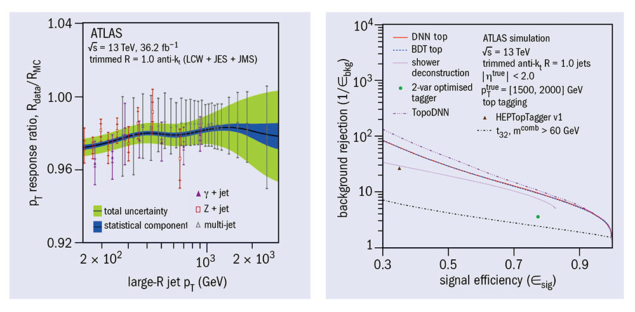A report from the ATLAS experiment
Ten years ago, the first in a series of annual meetings devoted to the theoretical and experimental understanding of massive hadronically decaying particles with high transverse momenta took place at SLAC. These “BOOST” workshops coincided with influential publications on the subject of reconstructing such Lorentz-boosted decays as single jets with large radius parameters [1], which kick-started the field of jet substructure. Such techniques have become a critical aspect of the ATLAS and CMS experimental programmes searching for new physics at the highest scales accessible with the LHC.
The understanding of large-radius jets and their substructure has progressed considerably. Analytical calculations have recently been published that predict the distribution of jet substructure observables at high accuracy, and these have been compared to data by both ATLAS [2] and CMS [3] in proton–proton collisions. Measurements of substructure observables have also recently been made by the ALICE, CMS and ATLAS collaborations in heavy ion collisions [4,5,6]. Such results were among the many topics discussed at the 10th BOOST workshop in Paris this July, where the ATLAS collaboration presented new results accentuating the advances in jet substructure.

Recent focus on measuring Standard Model properties using jet substructure has motivated ATLAS to measure the energy and mass response of large-radius jets with the highest possible precision [7]. A new in situ (that is, data-driven) calibration for large-radius jets provides percent-level uncertainties by combining several measurements of the jet energy scale in events where the jet is balanced by a well-measured reference object such as a leptonically decaying Z boson, a photon or a system of well-calibrated jets with lower momenta (figure, left). The mass scale of these jets is also measured using fits to the jet mass distribution obtained from hadronically decaying W bosons and top quarks in data, and by combining information from the ATLAS inner tracking detector and calorimeters. The precision for the jet mass scale in certain regions of parameter space also reaches the percent level, which is unprecedented for substructure observables.
Meanwhile, the ongoing revolution in machine learning has directly intersected with jet-substructure studies. Techniques such as boosted decision trees and deep neural networks have been studied by ATLAS to identify W bosons and top quarks with high transverse momenta [8]. These approaches allow several high-level substructure observables such as the mass, or low-level information such as measured energy depositions from the calorimeter, to be utilised simultaneously using their complex correlation pattern to gain information. Such techniques achieve improvements of more than 100% in terms of background rejection for top quark identification over previous results (figure, right).
In situ measurements of tagging and the background efficiencies of these algorithms robustly demonstrate that they are well understood in terms of the QCD-based models implemented in Monte Carlo generators, and are stable in the face of the challenging high pile-up environment of Run 2 at the LHC.
In two ATLAS publications, the early Run-2 data have allowed for rapid progress by enabling powerful in situ techniques. The collaboration is now looking forward to the possibilities offered by the larger full Run-2 dataset, where such data-driven calibrations will bring precision to an increasing number of observables. This will improve the quality of both searches and measurements exploring the energy frontier.
Further reading
[1] J Butterworth et al. 2008 Phys. Rev. Lett. 100 242001.
[2] ATLAS Collaboration 2018 Phys. Rev. Lett. 121 092001.
[3] CMS Collaboration 2018 arXiv:1807.05974.
[4] ALICE Collaboration 2018 arXiv:1807.06854.
[5] CMS Collaboration 2018 arXiv:1805.05145.
[6] ATLAS Collaboration 2018 ATLAS-CONF-2018-014.
[7] ATLAS Collaboration 2018 arXiv:1807.09477.
[8] ATLAS Collaboration 2018 arXiv:1808.07858.







